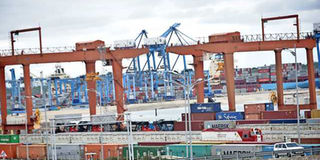Puzzle of idle Sh2bn giant SGR cranes at Mombasa port

The faulty standard gauge railway (SGR) gantry cranes at the Mombasa port on Thursday, May 16, 2019. The port has been forced to rely on Kenya Ports Authority cranes to load SGR containers. PHOTO | KEVIN ODIT | NATION MEDIA GROUP
What you need to know:
- Documents seen by the Sunday Nation reveal that in December last year, KRC asked the Chinese SGR operator to ensure the six mounted cranes were in use.
- The Chinese appeared to have ignored the instructions prompting a letter in January this year to CRBC general manager for operation Li Jiuping with similar demands that has also not been responded to.
Six giant cranes installed at the port of Mombasa to improve the loading and unloading of containers on the Standard Gauge Railway (SGR) have never worked since they were brought in two years ago at a cost of Sh2 billion, the Sunday Nation can reveal.
SAFETY
The rail-mounted cranes at Port Reitz were bought by the China Road and Bridge Corporation as part of the controversial SGR operations and maintenance contract to handle cargo on the Mombasa-Nairobi SGR. However, according to sources at the port, the massive equipment malfunctioned before breaking down and being abandoned by the contractor. CRBC built and operates the Chinese-funded SGR, which is Kenya’s single largest investment.
Investigations by the Sunday Nation reveal that the SGR operations at the port now largely depend on the rubber-tyred gantry cranes and those owned by the Kenya Ports Authority with little or no explanation on why the multi-billion-shillings investment is sitting idle.
Even more puzzling is that CRBC appears to have ignored communication from the Kenya Railways Corporation (KRC) to ensure that the cranes are either replaced or put in use. Each of the cranes cost Sh355 million, a figure that has also raised questions.
A port official who was present when the cranes were first tested, but who spoke in confidence, said they dropped the containers and appeared out of control, raising safety concerns.
IGNORED
“CRBC was asked to fix the problem. They brought in experts from China who failed to resolve the issue. They seemed to have given up and abandoned them,” said our source at the port.
Despite tests and inspections by China Hoisting and Conveying Equipment Quality Supervision Centre, the suppliers, in the presence of CRBC and KRC representatives in mid-October last year, the cranes have still not been put to use, putting into doubt the viability of this investment at the expense of the taxpayer.
Documents seen by the Sunday Nation reveal that in December last year, KRC asked the Chinese SGR operator to ensure the six mounted cranes were in use. The Chinese appeared to have ignored the instructions prompting a letter in January this year to CRBC general manager for operation Li Jiuping with similar demands that has also not been responded to.
On Saturday, Mr Sandy Feng, a CRBC communications official, said the company was not in a position to address the issues raised over the usage of the cranes and referred us to KRC.
“We appreciate your concerns over this matter and the operation of the SGR. However, as for the question you have raised, we suggest that you reach out to Kenya Railways Corporation to get much of the information you are seeking,” Mr Feng said despite indications in our enquiry that his company was responsible for the procurement and operations of the cranes.
KRC did not immediately respond to the questions redirected to them. However, Transport Cabinet Secretary James Macharia admitted that the cranes have never been used due to their operational challenges, adding that the country should expect new cranes in the next few months.
TARGET
“The cranes will be replaced by CRBC. We had a meeting with them on Thursday and that was the agreement. The first two cranes are expected to be replaced in the next few weeks. I am made to understand that their shipment has already started. Eventually, we shall get new replacements for the six,” Mr Macharia told Sunday Nation.
The situation has now forced Kenya Ports Authority (KPA) to move in and use its cranes to perform the tasks that CRBC was supposed to have done, depending on eight rubber-tyred gantry cranes to assist in loading, offloading and movement of containers around the yard. The port agency has also distanced its self from the non-functioning cranes, saying they are just a host of the CRBC and KRC. KPA said its six Rail Mounted Gantry (RMG) Cranes manufactured in China by ZPMC Ltd are working.
“We have an RMG station with the six cranes providing loading zones namely lines Z4, Z7, Z8, Z9 and Z10, whereby Z4 and Z9 are dedicated for loading of dangerous cargo on SGR. From these loading zones, the cranes are used to load the bloc trains. Without these six RMGs at the loading zones, then we would not be able to attain our daily target of 10-12 trains,” Mr Bernard Osero, KPA Head of Corporate Affairs, said.





